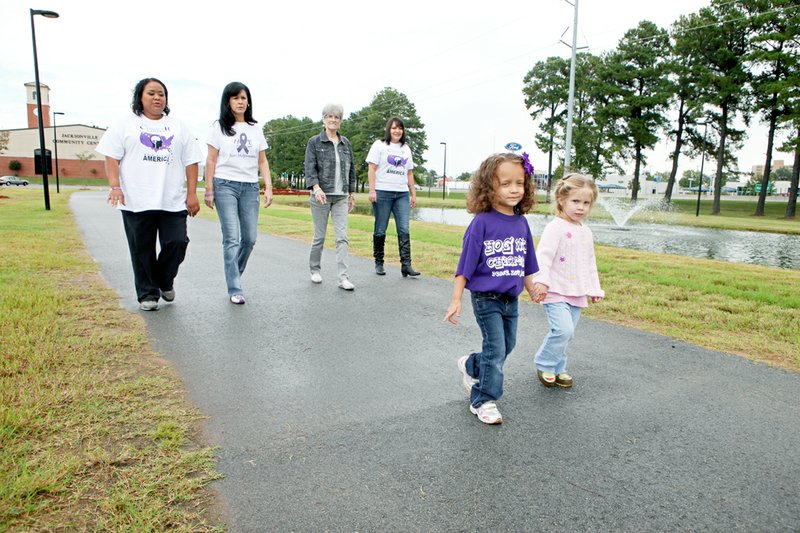Dana Gaines pulled out several prescription bottles from her purse, which was sitting in her lap. Lining up eight bottles on the table in front of her, she said she had more at home.
“The pain is so intolerable,” she said, laying her hands flat on top of the medicine bottles. “I have to have these just to function.”
She said the short drive from her home in Searcy to Cabot that day would probably put her in bed for the next couple of days.
Kimberly Stricklin of Jacksonville echoed Gaines’ comments.
“Sometimes I can’t even make it into the living room,” she said. “They call this the invisible illness. To look at us, you could never tell we were sick, but this takes the quality of life away, and it takes it away from our children.”
The women have Chiari malformation, a serious neurological disorder in which the bottom part of the brain descends out of the skull and crowds the spinal cord. This puts pressure on the brain and the spine, and that disrupts the normal flow of spinal fluid.
Just a few weeks ago, the women who were gathered around a table didn’t know each other. Because this illness isn’t common and even doctors are still learning about it, after a diagnosis, a patient may feel like he or she is all alone.
“I felt very alone, and it’s so unknown that we have to tell the doctors at the ER how to treat it,” said Gaines, who had already been to the emergency department three times in September
Although it is believed that Chiari malformation is congenital, symptoms may not develop or may worsen at any time. And sometimes a diagnosis is difficult to get.
The disorder may seem rare, but Dr. Anthony Capocelli of Fort Smith said it’s more common than most people know, but because most doctors know very little about it, the number of diagnoses is increasing as doctors learn about the disorder.
“Historically, it’s been difficult to diagnose,” said Capocelli, a neurosurgeon and Chiari specialist. “We didn’t know much about Chiari, and it was frequently diagnosed through autopsy.”
He said the only way it can be diagnosed is through magnetic resonance imaging, and because technology has improved so much and the imaging is so much clearer, the malformations are easier to detect.
Gaines said her parents started taking her to neurologists when she was a teenager because she had been having severe migraine-type headaches since she was 6. She said those headaches became intolerable by the time she was about 17. Hitting walls each time she went for an exam, she said she was convinced that it was all in her mind.
“Then one day, I was watching the Discovery Channel, and Mystery Diagnosis came on,” Gaines said. “I called my family doctor and said, ‘I know what I have.’”
She was finally diagnosed with Chiari when she was 31.
“There are days that you pretty much pray for death because the pain is so bad,” she said.
Gaines said she had surgery to relieve the pressure in her head, and her symptoms decreased for a couple of years. She is currently preparing for another surgery.
Capocelli said people who have headaches that are brought on or caused by pressure, such as coughing, bending over or lifting a heavy object, should request an MRI from their family doctor. It could be a symptom of Chiari or another serious condition.
Untreated, Chiari can be fatal. Capocelli said something as simple as a hard coughing spell could result in death.
Pam Hall of Jacksonville began telling the story of how her daughter, Wendi Snell, was diagnosed with Chiari in 2008 at the age of 36. Tears welling in her eyes, Hall said it has been two years since Snell’s death, and Hall is raising her two granddaughters.
“She had bad headaches,” Hall said about her daughter, who was a teacher at Murrell Taylor Elementary School in Jacksonville. “She had been to neurologists, but it was her eye doctor who found the Chiari.”
“It was during a regular exam, and the doctor said it could be a tumor or a pseudo tumor,” Misty Cagle, Snell’s sister added.
Hall’s voice quivered as she said, “Wendi’s girls are 8 and 12 now, and at night, Olivia (who is the youngest) starts crying for her mother.”
On the other end of the spectrum, 5-year-old Ki’Nani Cantrall is preparing for her second surgery to relieve the pressure in her head.
“She would cry and hold her head when she was a baby,” Cales Cantrall of Cabot said about her daughter. “She was diagnosed by accident when we lived in Germany. … Then in December 2010, she had an MRI at [Arkansas] Children’s Hospital and had surgery a week later.”
Cales said over-the-counter pain medications don’t alleviate Ki’Nani’s pain, so Cales said she hopes the second surgery that her daughter is preparing for this week will help.
“There is no cure,” Stricklin said. “Almost everyone has to have more than one surgery.”
Gaines pulled up the back of her hair and revealed a tattoo on her neck that covers her scar.
“It’s a Japanese Kanji for victory,” she said. “This is not going to get me. … There’s nothing wrong with me; this is just what I have.”
The women are attempting to start a support group for people who have Chiari malformation and their families. For more information on the support group, contact Cales Cantrall at (888) 885-9514 or cales.cantrall@gmail.com.
Staff writer Jeanni Brosius can be reached at (501) 244-4307 or jbrosius@arkansasonline.com.
